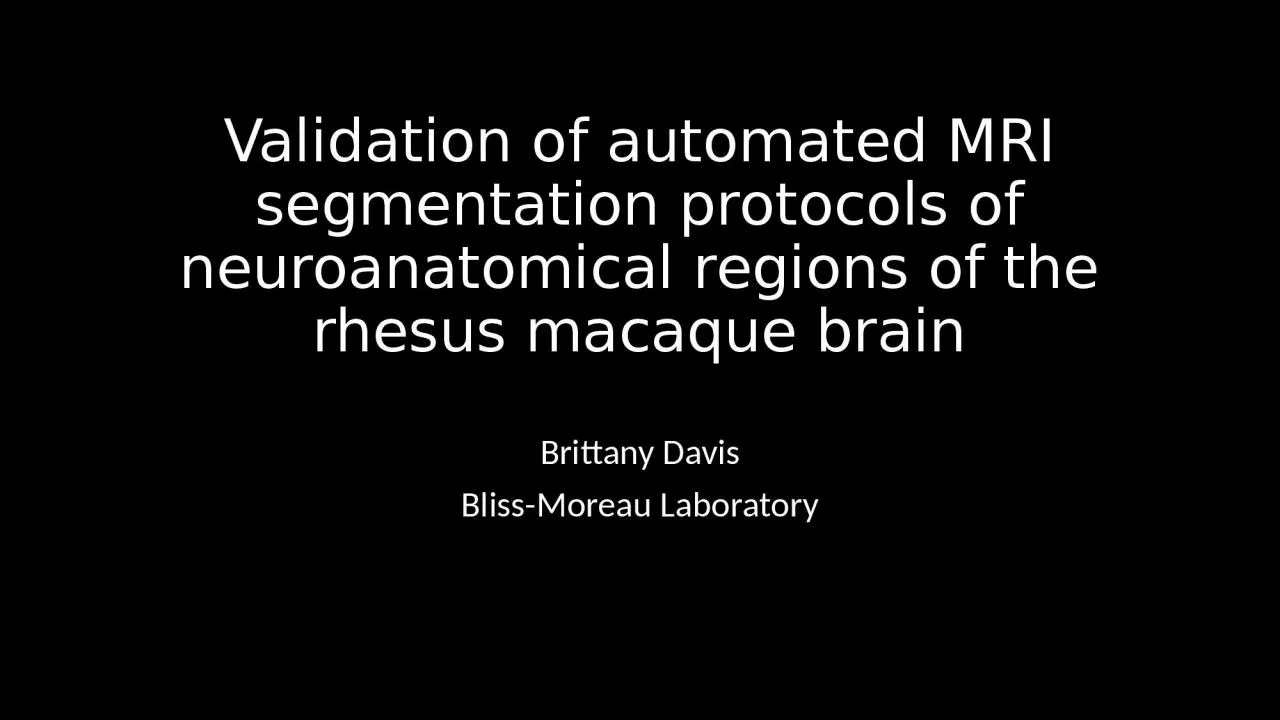

Brittany Davis BlissMoreau Laboratory MRI as a neuroanatomical tool in vivo National Institute of Mental Health Macaque Template NMT v2 Brain MRI and Histology Atlases Seidlitz et al 2018 ID: 1034915
Download Presentation The PPT/PDF document "Validation of automated MRI segmentation..." is the property of its rightful owner. Permission is granted to download and print the materials on this web site for personal, non-commercial use only, and to display it on your personal computer provided you do not modify the materials and that you retain all copyright notices contained in the materials. By downloading content from our website, you accept the terms of this agreement.
1. Validation of automated MRI segmentation protocols of neuroanatomical regions of the rhesus macaque brainBrittany DavisBliss-Moreau Laboratory
2.
3. MRI as a neuroanatomical tool in vivoNational Institute of Mental Health Macaque Template: “NMT v2 Brain” MRI and Histology Atlases:Seidlitz et al., 2018Saleem & Logothetis, 2012Paxinos et al., 2009
4.
5. Aims and HypothesesPrimary Aim: Compare the performance of automated and hand segmentation methods on subcortical and cortical regions of interest (ROIs).Hypothesis: Applying automated segmentation methods to MRI data will not result in reliable morphometric and volumetric measurements of subcortical (amygdala) and cortical (insula) structures in juvenile and adult rhesus macaques.
6. Methods16 rhesus macaques14 females, 2 males1.1-20.3 years oldGroup housed at CNPRCT1w images acquired on Siemens 3T Skyra
7. Methods: Hand Segmentation of ROIsSubcortical AmygdalaCortical InsulaYushkevich et al., 2006
8. Methods: Automated Segmentation of Subcortical ROIs using SARMNMT v 2.0 Template BrainSubject BrainHartig et al., 2021
9. Methods: Automated Segmentation of Cortical ROIs using CHARMNMT v 2.0 Template BrainSubject BrainJung et al, 2021
10. Methods: AnalysisPlan:Calculate and compare relative volumes for amygdala and insula between automated and hand segmentation methodsAre relative volumes from automated segmentation a significant predictor of volumes from hand segmentation?
11. Results:
12. Results:Linear Mixed Model :Auto segmented volume was NOT a significant predictor of hand segmented volume2 (1) = 0.35, p = 0.56No effect of age 2 (1) = 0.38, p = 0.53No effect of sex 2 (1) = 1.96, p = 0.16r = -0.16 p = 0.54
13. Results:
14. Results:Linear Regression Model :Auto segmented volume WAS a significant predictor of hand segmented volume2 (1) = 10.91, p < 0.001No effect of age 2 (1) = 0.04, p = 0.83No effect of sex 2 (1) = 0.57, p = 0.45r = 0.71p < 0.01
15. Results and InterpretationAutomated segmentation volumes were a significant predictor for hand segmentation volumes in the insula but not in the amygdala.Differences in grey-white matter boundaries?Implications: Using automated atlases may lead to drawing incorrect conclusions about the volumes of anatomical structures and their relationships to one another.
16. Future DirectionsExpand data set to include second cohort (this summer)Troubleshoot and optimize automated segmentation methodsCreate our own mask on NMT brain, utilize pipeline to apply thatConsider surface or hybridized automated methodsCurrently working with one of the developers of these atlases to troubleshoot differences between SARM and manual methods Investigate the performance of automated segmentation methods in additional ROIs
17. AcknowledgementsBliss-Moreau LaboratoryPI: Eliza Bliss-Moreau, PhDStaff Research Associate: Jeff BennettPhD Candidate: Joey CharbonneauPostdoctoral Scholar: Erika Raven, PhDFinancial support was provided by the Students Training in Advanced Research (STAR) Program through a UC Davis School of Veterinary Medicine Endowment Fund
18. ReferencesHartig, R., Glen, D., Jung, B., Logothetis, N. K., Paxinos, G., Garza-Villarreal, E. A., Messinger, A., & Evrard, H. C. (2021). The Subcortical Atlas of the Rhesus Macaque (SARM) for neuroimaging. Neuroimage, 235, 117996. https://doi.org/10.1016/j.neuroimage.2021.117996 Jung, B., Taylor, P. A., Seidlitz, J., Sponheim, C., Perkins, P., Ungerleider, L. G., Glen, D., & Messinger, A. (2021). A comprehensive macaque fMRI pipeline and hierarchical atlas. Neuroimage, 235, 117997. https://doi.org/10.1016/j.neuroimage.2021.117997 Paxinos, G., Huang, X.F., Petrides, M., Toga, A.W. (2009). The Rhesus Monkey Brain in Stereotaxic Coordinates (2nd Ed.) Academic Press, Elsevier Inc..Saleem, K., & Logothetis, N. (2012). A combined MRI and Histology Atlas of the Rhesus Monkey Brain in Stereotaxic Coordinates. 2nd edition with Horizontal, Coronal, and Sagittal Series. Elsevier/Academic Press. Seidlitz, J., Sponheim, C., Glen, D., Ye, F. Q., Saleem, K. S., Leopold, D. A., Ungerleider, L., & Messinger, A. (2018). A population MRI brain template and analysis tools for the macaque. Neuroimage, 170, 121-131. https://doi.org/https://doi.org/10.1016/j.neuroimage.2017.04.063 Yushkevich, P. A., Piven, J., Hazlett, H. C., Smith, R. G., Ho, S., Gee, J. C., & Gerig, G. (2006). User-guided 3D active contour segmentation of anatomical structures: Significantly improved efficiency and reliability. Neuroimage, 31(3), 1116-1128. https://doi.org/https://doi.org/10.1016/j.neuroimage.2006.01.015
19. Questions?cnprc.ucdavis.edu
20. Supplemental Slides
21. Animal Descriptive Data: Age
22. Animal Descriptive Data: Weight
23. Automated Segmentation Process
24. Amygdala AS ROIsBMbasomedial amygdaloid nucleusVCoventral cortical amygdaloid nucleusAHiamydalopiriform transitionLalateral amygdaloid nucleusAPiramygdalopiriform transitionBLbasolateral amygdaloid nucleusPaLparalaminar amygdaloid nucleusMemedian amygdaloid nucluesAAanterior amygdaloid areaSTIAintra-amygdaloid division of the bed nucleus of the stria terminalisInsula AS ROIsIam/Iapmmedial agranular insular regionIaiintermediate agranular insula areaIallateral agranular insula areaIaplposterior lateral agranular insula areaGgustatory cortexPiparainsulaIa/Idagranular and dysgranular insulaIggranular insulaRiretroinsula
25. Results: Amygdala (Absolute Volumes)Hand Seg:Mean +/- SD L: 263.9464 +/- 29.2117Mean +/- SD R: 263.1116 +/- 19.7427Auto Seg:Mean +/- SD L: 341.4677 +/- 44.1882Mean +/- SD R: 358.6346 +/- 56.3938
26. Results: Insula (Absolute Volumes)Hand Seg:Mean +/- SD L: 549.6392 +/- 76.9402Mean +/- SD R: 503.4722 +/- 53.7549Auto Seg:Mean +/- SD L: 502.7597 +/- 56.8576Mean +/- SD R: 492.1816 +/- 60.3310
27. Auto v Hand Seg By HemisphereAmygdalaInsula
28. 35580 segmentation differencesL-most pane: hand segmentationMiddle pane: auto segmentationR-most pane: no segmentation
29. 41083 segmentation differencesL-most pane: hand segmentationMiddle pane: auto segmentationR-most pane: no segmentation